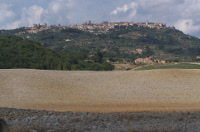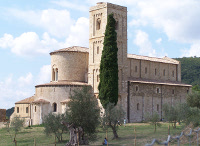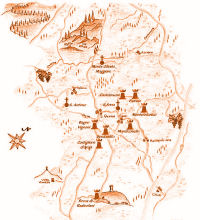The hill upon which Montalcino sits has probably been settled since Etruscan times. Its first mention in historical documents in 814 AD suggests there was a church here in the 9th century, most likely built by monks associated with the nearby Abbey of Sant'Antimo. The population grew suddenly in the middle of the tenth century, when people fleeing the nearby town of Roselle took up residence in the town.
The town takes its name from a variety of oak tree that once covered the terrain. The very high site of the town offers stunning views over the Asso, Ombrone and Arbia valleys of Tuscany, dotted with silvery olive orchards, vineyards, fields and villages. The lower slopes of the Montalcino hill itself are dominated by highly productive vines and olive orchards.
During medieval times the city was known for its tanneries and for the shoes and other leather goods that were made from the high-quality leathers that were produced there.
Like many of the medieval towns of Tuscany, Montalcino experienced long periods of peace and often enjoyed a measure of prosperity. This peace and prosperity was, however, interrupted by a number of extremely violent episodes.
During the late Middle Ages it was an independent commune with considerable importance owing to its location on the old Via Francigena, the main road between France and Rome, but increasingly Montalcino came under the sway of the larger and more aggressive city of Siena.
In the case of Montalcino, gradual economic decline has recently been reversed by economic growth due to the increasing popularity of the town's famous wine Brunello di Montalcino, made from the sangiovese grosso grapes grown within the comune.
 Montalcino |  Abbazia di Sant'Antimo | ||
| |||
Sant'Antimo
The Abbey of Sant'Antimo, is a former Benedictine monastery approximately 10 km from Montalcino about 9 km from the Via Francigena, the pilgrim route to Rome. Disused for many years, the abbey has since 1992 been in use by a small community of Premonstratensian Canons Regular. A tributary of the river Orcia, the Starcia, runs near the abbey.


